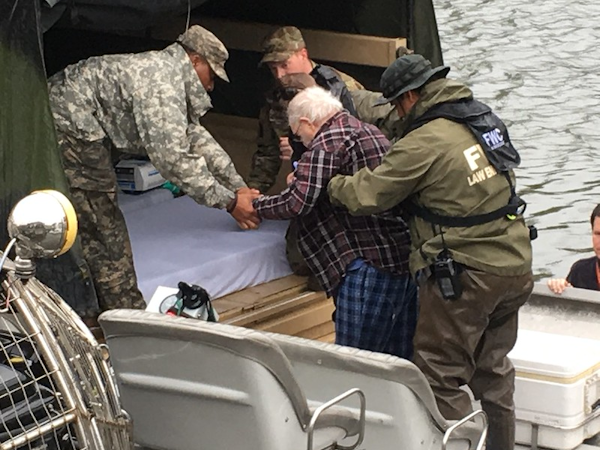SEJournal Online is the digital news magazine of the Society of Environmental Journalists. Learn more about SEJournal Online, including submission, subscription and advertising information.
 |
 |
| Louisiana National Guardsmen assist with the evacuation of a nursing home in Orange, Texas, in the aftermath of Hurricane Harvey in August 2017. Photo: National Guard via Flickr Creative Commons (CC BY 2.0). |
TipSheet: When Disasters Hit, Nursing Homes Can Be Disasters Waiting To Happen
By Joseph A. Davis
The recent spate of hurricanes and other climate-driven disasters like wildfires is a stark reminder that unless the most vulnerable people are protected, communities are not ready.
It’s an important story almost everywhere — and a key one for environmental journalists.
Think nursing homes.
We use the common term, “nursing home,” broadly to include many kinds of health care facilities. They are regulated, at least theoretically, by a complex patchwork of state, federal and even local governments and laws.
Most of those rules require
nursing homes to be prepared to
protect their patients from disasters.
But they don’t all do it. Or do it effectively.
Most of those rules require nursing homes to be prepared to protect their patients from disasters.
But they don’t all do it. Or do it effectively. That’s the story.
Why it matters
Roughly 1.2 million people live in some 15,300 nursing homes and similar facilities, 70% of which are privately owned and operated.
But just because your aging mom or recovering uncle is in a nursing home doesn't mean you don’t care about them. In fact, most people in homes require more constant care than those who love them are able to provide.
Their care may involve feeding them, changing them, dressing them and paying attention to their medical needs. Not to mention their need for companionship and community. Your aunt with Alzheimer’s disease may need someone to keep her from wandering off into the neighborhood.
The backstory
There have been countless disasters: hurricanes, floods, heat waves, wildfires, power failures and even pandemics. These disasters can quickly overwhelm a nursing home’s ability to keep patients healthy … or even alive.
An extreme and tragic example is the case of Memorial Medical Center in New Orleans, where flooding from 2005’s Hurricane Katrina inundated and crippled much of the city. This facility was unable to evacuate, and at least 45 people died in this event.
It is a dark story witnessed by physician and investigative reporter Sheri Fink, who wrote about it in an article and book that eventually won a Pulitzer Prize.
Story ideas
- Who regulates nursing homes, and their emergency preparedness, in your state or area? Talk to them. Check their record.
- Ask to see disaster preparedness plans for facilities in your area. Are they complete? Adequate? Realistic?
- Look for actual disasters in which nursing homes have been evacuated in your area. How was it done? How did it work? Where did the patients go? Does it vary by the kind of disaster?
- How do patients with breathing problems deal with wildfire smoke in your area? Do nursing homes have protective ventilation systems?
- Have there been extreme heat events in your area? How did patients in nursing homes fare? How robust are the air conditioning systems? What happens when the power fails?
- How do nursing homes in your area deal with power failures? Do they have generators? What happens to powered medical equipment?
- What happens when municipal drinking water for nursing homes in your area is shut off or polluted?
Reporting resources
- Centers for Medicare & Medicaid Services: The main federal agency overseeing the regulation of nursing homes. See its Emergency Preparedness Rule.
- State Regulatory Agencies: All states have agencies that regulate nursing home care. Here is a directory.
- American Health Care Association: The lobbying group, partnering with the National Center for Assisted Living, represents the interests of the nursing home industry. It has an emergency preparedness resource page.
- National Consumer Voice for Quality Long-Term Care: This group educates and advocates for patients and families. It offers some useful disaster-preparedness checklists.
- Centers for Disease Control and Prevention: The CDC is a good source of statistics on nursing home and similar care.
[Editor’s Note: For related stories see TipSheets on community readiness for tornadoes and heat wave-related blackouts, Reporter’s Toolboxes on a climate vulnerability index and on ID’ing vulnerable communities, an Issue Backgrounder on climate resiliency and cascading disasters and a Feature on disabilities and disasters. Plus, see disaster headlines from EJToday.]
Joseph A. Davis is a freelance writer/editor in Washington, D.C. who has been writing about the environment since 1976. He writes SEJournal Online's TipSheet, Reporter's Toolbox and Issue Backgrounder, and curates SEJ's weekday news headlines service EJToday and @EJTodayNews. Davis also directs SEJ's Freedom of Information Project and writes the WatchDog opinion column.
* From the weekly news magazine SEJournal Online, Vol. 9, No. 40. Content from each new issue of SEJournal Online is available to the public via the SEJournal Online main page. Subscribe to the e-newsletter here. And see past issues of the SEJournal archived here.













 Advertisement
Advertisement 



